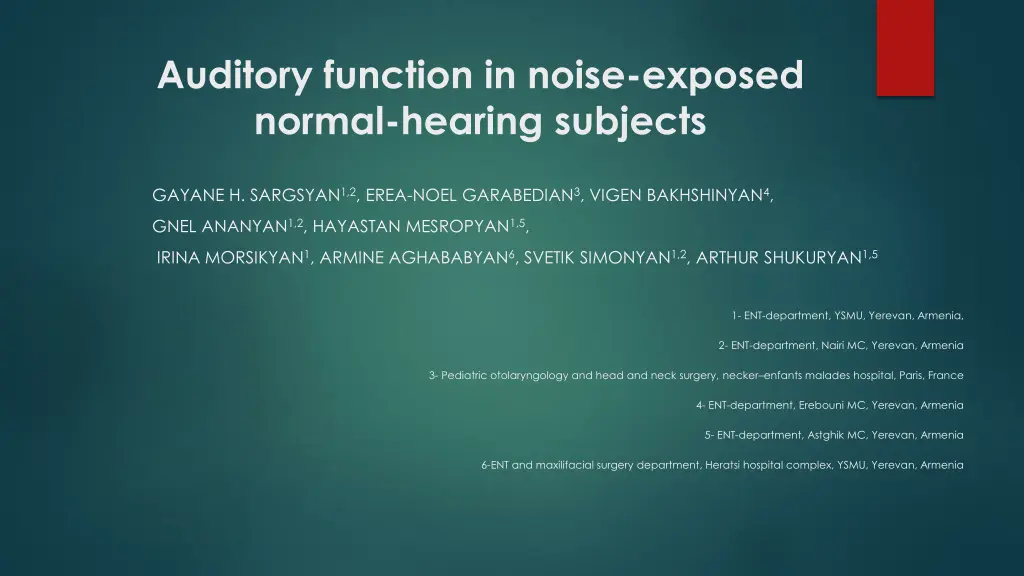
Assessment of Cochlear Function in Noise-Exposed Normal Hearing Individuals
This study aims to evaluate the cochlear function in individuals with normal hearing who have been exposed to noise. The research examines the impact of noise exposure on outer hair cells and synaptopathic processes in the cochlea. Through detailed analysis, the study sheds light on potential risks and effects of noise-induced damage on auditory health.
Download Presentation

Please find below an Image/Link to download the presentation.
The content on the website is provided AS IS for your information and personal use only. It may not be sold, licensed, or shared on other websites without obtaining consent from the author. If you encounter any issues during the download, it is possible that the publisher has removed the file from their server.
You are allowed to download the files provided on this website for personal or commercial use, subject to the condition that they are used lawfully. All files are the property of their respective owners.
The content on the website is provided AS IS for your information and personal use only. It may not be sold, licensed, or shared on other websites without obtaining consent from the author.
E N D
Presentation Transcript
Auditory function in noise-exposed normal-hearing subjects GAYANE H. SARGSYAN1,2, EREA-NOEL GARABEDIAN3, VIGEN BAKHSHINYAN4, GNEL ANANYAN1,2, HAYASTAN MESROPYAN1,5, IRINA MORSIKYAN1, ARMINE AGHABABYAN6, SVETIK SIMONYAN1,2, ARTHUR SHUKURYAN1,5 1- ENT-department, YSMU, Yerevan, Armenia, 2- ENT-department, Nairi MC, Yerevan, Armenia 3- Pediatric otolaryngology and head and neck surgery, necker enfants malades hospital, Paris, France 4- ENT-department, Erebouni MC, Yerevan, Armenia 5- ENT-department, Astghik MC, Yerevan, Armenia 6-ENT and maxilifacial surgery department, Heratsi hospital complex, YSMU, Yerevan, Armenia
Introduction The key indicator of noise-induced hearing loss is outer hair cell death(Bramhall NF, et al., 2017) Otoacoustic emissions (OAEs) are an early indicators of noise-induced damage or as a method to determine potential risks for developing noise-induced hearing loss (Attias J., et al., 2001; Lapsley Miller JA, et al., 2006; Marshall L, et al., 2009) Work in animal models has demonstrated that in noise-induced hearing loss, such exposures caused only reversible threshold shifts (and no hair cell loss); however, they did result in the permanent loss of >50% of cochlear nerve/hair cell synapses(Kujawa SG et al., 2015) Noise-induced cochlear synaptopathic injury cannot be detected by a conventional audiometric assessment of threshold sensitivity(Tepe V., et al., 2017) Studies in animal models with noise-induced and age-related synaptopathies have shown reductions in the ABR wave I amplitude(Lin HW, et al., 2011; Furman AC., et al., 2013) Noise exposure can result in decrease in the amplitudes of ABR waves I and V(Kaf WA.,et al., 2022 ) The amplitudes of ABR waves I and V were not significantly related to the noise exposure backgrounds subjects(Stamper GC, et al., 2015)
AIM The goal of this study was to assess cochlear function in normal hearing subjects after noise-induced exposure. We examined the outer hair cells and the synaptopathic processes of the cochlea and the effect incurred on them by noise. Funding: Science Committee of Republic Armenia, grant number 21T-3B161.
Materials and Methods Soldier(experimental) group, n=20(40 ears) Age- 20 to 39 years (mean age = 22.7 years) Inclusion criteria- hearing thresholds of 250-8000 Hz 20 dB normal middle ear function absence of any contemporary hearing loss during or after the war absence of any subjective hearing loss Control group, n=20(40 ears) Age- 19-41 years (mean age = 22.9 years old) Inclusion criteria- hearing thresholds of 250-8000 Hz 20 dB normal middle ear function no previous long-term high-level noise exposure
Materials and Methods Pure tone audiometry -the standard (250-8000 Hz) frequency range and at 12000 Hz DPOAE testing (2f1-f2 DP-gram, L1=65 dB sound pressure level (SPL), L2 =55 dB SPL, f2/f1 = 1.22); ABR testing -suprathreshold intensity of 80 dB normal Hearing Level (nHL) (stimulation with pulses of alternating polarity at a stimulation rate of 13.1 per second and filtered from 0.1 to 1.5 kHz), including assessment of the amplitude and latency of ABR waves I and V
Results: Hearing thresholds 250-8000 Hz - no significant difference (inclusion criteria for participants) at 12000 Hz-significant difference(<0.05)
Results: DPOAE DPOAE thresholds at different tested frequencies Group Frequency Sig. (2-tailed) 0.271 1000Hz experimental control 0.343 2000Hz experimental control * 0.008 4000Hz experimental control 0.058 6000Hz experimental control experimental 0.122 8000Hz control
Results: ABR ABR wave I, V and I-V interpeak latencies and correlations between groups Group Ear ,N Mean Std. Deviation Sig. (2- tailed) Latency, ms Wave I experimental 40 1.5567 0.27877 * 0.007 control 40 1.4585 0.16198 Wave V experimental 40 5.4705 0.30757 * 0.044 control 40 5.3799 0.25726 Waves I V experimental 40 3.9387 0.32669 0.710 *-significant differences control 40 3.9222 0.22602
Results: ABR ABR wave I and V amplitudes and correlations between groups Group Ear ,N Mean Amplitude , V Std. Deviation Sig. (2- tailed) Wave I experimental 40 0.1904 0.09462 *0.000 control 40 0.2485 0.10032 Wave V experimental 40 0.4445 0.15944 *0.023 0.5030 control 40 0.16475 *-significant differences
Summary The significant differences were found: PTA at 12000 Hz between the 2 groups (<0.05) DPOAE at 4000 Hz between the 2 groups (<0.05) ABR wave I amplitude(<0.001) and latency (<0.01)between the 2 groups ABR wave V amplitude (<0.05) and latency(<0.05)between the 2 groups No difference of the ABR wave I-V interpeak latencies between the 2 groups was found
Conclusions High noise exposure can cause the simultaneous outer hair cell damage and synaptopathic impairment The electrophysiological audiological testing is necessary in patients after high noise exposure Acquired changes after high noise exposure cannot be detected using standard audiometric tests High importance of follow-up monitoring of the auditory function in noise- exposed patient
